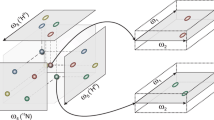Abstract
Grouping of spectral peaks into J-connected spin systems is essential in the analysis of macromolecular NMR data as it provides the basis for disentangling chemical shift degeneracies. It is a mandatory step before resonance and NOESY cross-peak identities can be established. We have developed SPI, a computational protocol that scrutinizes peak lists from homo- and hetero-nuclear multidimensional NMR spectra and progressively assembles sets of resonances into consensus J- and/or NOE-connected spin systems. SPI estimates the likelihood of nuclear spin resonances appearing at defined frequencies given sets of cross-peaks measured from multi-dimensional experiments. It quantifies spin system matching probabilities via Bayesian inference. The protocol takes advantage of redundancies in the number of connectivities revealed by suites of diverse NMR experiments, systematically tracking the adequacy of each grouping hypothesis. SPI was tested on 2D homonuclear and 2D/3D15N-edited data recorded from two protein modules, the col 2 domain of matrix metalloproteinase-2 (MMP-2) and the kringle 2 domain of plasminogen, of 60 and 83 amino acid residues, respectively. For these protein domains SPI identifies ∼ 95% unambiguous resonance frequencies, a relatively good performance vis-à-vis the reported `manual' (interactive) analyses.
Abbreviations and Acronyms: SPI, SPin Identification; BMRB, BioMagResBank (Madison, WI).
Similar content being viewed by others
References
Atkinson, R.A. and Saudek, V. (2002) FEBS Lett., 510, 1–4.
BioMagResBank,http://www.bmrb.wisc.edu/
Briknarová, K., Grishaev, A., Banyai, L., Tordai, H., Patthy, L. and Llinás, M. (1999)Structure, 7, 1235–1245.
Chen, J., Mandelstham, V.A. and Shaka, A.J. (2000) J. Magn. Reson., 146,363–368.
Croft, D., Kemmink, J., Neidig, K.P. and Oschkinat, H. (1997) J. Biomol. NMR, 10, 207–219.
Grishaev, A. and Llinás, M. (2002a) Proc. Natl. Acad. Sci. USA, 99, 6707–6712.
Grishaev, A. and Llinás, M.(2002b) Proc. Natl. Acad. Sci. USA, 99, 6713–6718.
Jaynes, E.T. (1996) Probability Theory – The Logics ofScience. USA, http://omega.albany.edu:8008/JaynesBook.html
Kleywegt, G.J., Boelens, R., Cox, M., Llinás, M., and Kaptein, R. (1991) J. Biomol. NMR, 1, 23–47.
Lukin, J.A., Grove, A.P., Talukdar, S.N. and Ho, C. (1997) J.Biomol. NMR 9, 151–166.
Marti, D., Schaller, J. and Llinás, M. (1999) Biochemistry, 38, 15741–15755.
Piotto, M., Saudek, V. and Sklenar, V. (1992) J. Biomol. NMR, 2, 661–665.
Xu, J., Weber, P.L. and Borer, P.N. (1995) J. Biomol. NMR, 5, 183–192.
Zimmerman, D.E., Kulikowski, C.A., Huang, Y.P., Feng, W.Q., Tashiro, M., Shimotakahara, S., Chien, C.Y., Powers, R. and Montelione, G.T. (1997) J. Mol. Biol., 269, 592–610.
Author information
Authors and Affiliations
Corresponding author
Rights and permissions
About this article
Cite this article
Grishaev, A., Llinás, M. Sorting signals from protein NMR spectra: SPI, a Bayesian protocol for uncovering spin systems. J Biomol NMR 24, 203–213 (2002). https://doi.org/10.1023/A:1021660608913
Issue Date:
DOI: https://doi.org/10.1023/A:1021660608913




